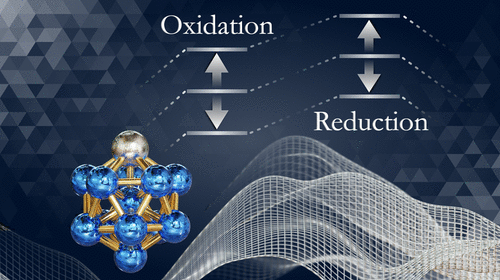当前位置:
X-MOL 学术
›
ACS Catal.
›
论文详情
Our official English website, www.x-mol.net, welcomes your
feedback! (Note: you will need to create a separate account there.)
Developing Efficient Suzuki Cross-Coupling Catalysts by Doping Palladium Clusters with Silver
ACS Catalysis ( IF 11.3 ) Pub Date : 2021-08-31 , DOI: 10.1021/acscatal.1c02083 Turbasu Sengupta 1 , Dinesh Bista 1 , Shiv N. Khanna 1
ACS Catalysis ( IF 11.3 ) Pub Date : 2021-08-31 , DOI: 10.1021/acscatal.1c02083 Turbasu Sengupta 1 , Dinesh Bista 1 , Shiv N. Khanna 1
Affiliation

|
It is shown that doping of a Pd cluster by Ag atoms can provide an efficient catalyst for the Suzuki–Miyaura cross-coupling reactions. We demonstrate this intriguing possibility by considering a model reaction involving bromobenzene and phenylboronic acid as reagents where the reaction involves oxidation, transmetallation, and reduction steps. We have examined the reaction barriers of all three steps for a conventional ligated Pd catalyst, a nearly icosahedral Pd13 cluster, and a monosilver-doped Pd12Ag cluster using gradient-corrected density functional theory. It is observed that the reaction carried out on the Pd sites adjacent to an Ag atom in a Pd12Ag cluster shows substantially lower barriers for the oxidation and reduction steps compared to the conventional ligated Pd catalyst and the pure Pd13 cluster. A detailed analysis indicates that the Ag site donates charge to the neighboring Pd site. While such a donation may have been expected to reduce the barrier for the oxidative step, the lowering of the barrier for the reduction step indicates that the respective sites not only act as a donor but can also serve as an acceptor for the reduction step. Furthermore, because of the differential donor–acceptor characteristic of the Ag and Pd atoms, it is observed that the barrier heights of the redox steps are primarily dependent on the chosen active site. The calculated results show that by altering the atom (Ag or Pd) at the active site of the reaction, the activation energies of the redox steps can either be reduced or increased. This shows that the active sites of a bimetallic cluster-like Pd12Ag can be utilized to control the barrier heights of suitable chemical reactions. The relative trend of the barrier heights for both clusters is also observed to be predictable by the conceptual density functional theory. Previous studies in our group have indicated that the reaction barriers for Pdn clusters can be lowered by supporting them on reduced graphene. We, therefore, propose that silver-doped Pdn clusters may provide an even better catalyst.
中文翻译:

通过用银掺杂钯簇开发高效的铃木交叉偶联催化剂
结果表明,Ag 原子掺杂 Pd 簇可以为 Suzuki-Miyaura 交叉偶联反应提供有效的催化剂。我们通过考虑涉及溴苯和苯基硼酸作为试剂的模型反应来证明这种有趣的可能性,其中反应涉及氧化、金属转移和还原步骤。我们已经使用梯度校正密度泛函理论检查了传统连接 Pd 催化剂、接近二十面体的 Pd 13簇和单银掺杂的 Pd 12 Ag 簇的所有三个步骤的反应障碍。观察到反应在 Pd 12 中与 Ag 原子相邻的 Pd 位点上进行与传统的连接 Pd 催化剂和纯 Pd 13相比,Ag 簇在氧化和还原步骤中显示出明显更低的势垒簇。详细分析表明,Ag 站点向邻近的 Pd 站点捐赠电荷。虽然这种捐赠可能会降低氧化步骤的屏障,但还原步骤屏障的降低表明各个位点不仅充当供体,还可以充当还原步骤的受体。此外,由于 Ag 和 Pd 原子的不同施主 - 受主特征,据观察,氧化还原步骤的势垒高度主要取决于所选的活性位点。计算结果表明,通过改变反应活性位点的原子(Ag 或 Pd),可以降低或增加氧化还原步骤的活化能。这表明双金属簇状 Pd 12的活性位点Ag 可用于控制合适化学反应的势垒高度。概念密度泛函理论也观察到两个簇的势垒高度的相对趋势是可预测的。我们小组先前的研究表明,可以通过在还原石墨烯上支持Pd n簇来降低它们的反应势垒。因此,我们建议银掺杂的 Pd n簇可以提供更好的催化剂。
更新日期:2021-09-17
中文翻译:

通过用银掺杂钯簇开发高效的铃木交叉偶联催化剂
结果表明,Ag 原子掺杂 Pd 簇可以为 Suzuki-Miyaura 交叉偶联反应提供有效的催化剂。我们通过考虑涉及溴苯和苯基硼酸作为试剂的模型反应来证明这种有趣的可能性,其中反应涉及氧化、金属转移和还原步骤。我们已经使用梯度校正密度泛函理论检查了传统连接 Pd 催化剂、接近二十面体的 Pd 13簇和单银掺杂的 Pd 12 Ag 簇的所有三个步骤的反应障碍。观察到反应在 Pd 12 中与 Ag 原子相邻的 Pd 位点上进行与传统的连接 Pd 催化剂和纯 Pd 13相比,Ag 簇在氧化和还原步骤中显示出明显更低的势垒簇。详细分析表明,Ag 站点向邻近的 Pd 站点捐赠电荷。虽然这种捐赠可能会降低氧化步骤的屏障,但还原步骤屏障的降低表明各个位点不仅充当供体,还可以充当还原步骤的受体。此外,由于 Ag 和 Pd 原子的不同施主 - 受主特征,据观察,氧化还原步骤的势垒高度主要取决于所选的活性位点。计算结果表明,通过改变反应活性位点的原子(Ag 或 Pd),可以降低或增加氧化还原步骤的活化能。这表明双金属簇状 Pd 12的活性位点Ag 可用于控制合适化学反应的势垒高度。概念密度泛函理论也观察到两个簇的势垒高度的相对趋势是可预测的。我们小组先前的研究表明,可以通过在还原石墨烯上支持Pd n簇来降低它们的反应势垒。因此,我们建议银掺杂的 Pd n簇可以提供更好的催化剂。











































 京公网安备 11010802027423号
京公网安备 11010802027423号